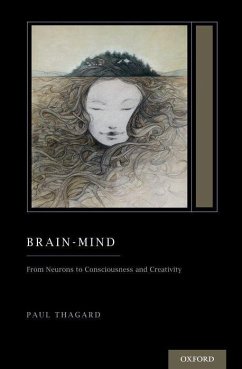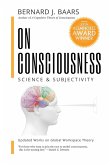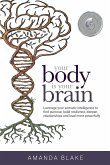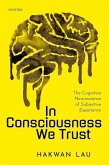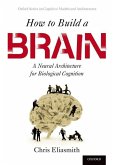Paul Thagard (Professor, Professor, Distinguished Emeritus Professo
Brain-Mind
From Neurons to Consciousness and Creativity (Treatise on Mind and Society)
Paul Thagard (Professor, Professor, Distinguished Emeritus Professo
Brain-Mind
From Neurons to Consciousness and Creativity (Treatise on Mind and Society)
- Broschiertes Buch
- Merkliste
- Auf die Merkliste
- Bewerten Bewerten
- Teilen
- Produkt teilen
- Produkterinnerung
- Produkterinnerung
How do brains make minds? Paul Thagard's Brain-Mind presents a unified, brain-based theory of cognition and emotion with applications to the most complex kinds of thinking, right up to consciousness and creativity. Neural mechanisms are used to explain mental operations for analogy, action, intention, language, and the self.
Andere Kunden interessierten sich auch für
![ON CONSCIOUSNESS ON CONSCIOUSNESS]() Bernard J BaarsON CONSCIOUSNESS52,99 €
Bernard J BaarsON CONSCIOUSNESS52,99 €![The Microgenetic Theory of Mind and Brain The Microgenetic Theory of Mind and Brain]() Jason W. BrownThe Microgenetic Theory of Mind and Brain71,99 €
Jason W. BrownThe Microgenetic Theory of Mind and Brain71,99 €![Your Body is Your Brain Your Body is Your Brain]() Amanda BlakeYour Body is Your Brain18,99 €
Amanda BlakeYour Body is Your Brain18,99 €![In Consciousness We Trust In Consciousness We Trust]() Hakwan Lau (Team Leader, Team Leader, Laboratory for Consciousness,In Consciousness We Trust42,99 €
Hakwan Lau (Team Leader, Team Leader, Laboratory for Consciousness,In Consciousness We Trust42,99 €![The Oxford Handbook of Music and the Brain The Oxford Handbook of Music and the Brain]() The Oxford Handbook of Music and the Brain63,99 €
The Oxford Handbook of Music and the Brain63,99 €![How To Build A Brain How To Build A Brain]() Chris Eliasmith ( Canada Research Chair in Theoretical NeuroscienceHow To Build A Brain46,99 €
Chris Eliasmith ( Canada Research Chair in Theoretical NeuroscienceHow To Build A Brain46,99 €![The Mind: Consciousness, Prediction, and the Brain The Mind: Consciousness, Prediction, and the Brain]() E. Bruce GoldsteinThe Mind: Consciousness, Prediction, and the Brain33,99 €
E. Bruce GoldsteinThe Mind: Consciousness, Prediction, and the Brain33,99 €-
-
-
How do brains make minds? Paul Thagard's Brain-Mind presents a unified, brain-based theory of cognition and emotion with applications to the most complex kinds of thinking, right up to consciousness and creativity. Neural mechanisms are used to explain mental operations for analogy, action, intention, language, and the self.
Hinweis: Dieser Artikel kann nur an eine deutsche Lieferadresse ausgeliefert werden.
Hinweis: Dieser Artikel kann nur an eine deutsche Lieferadresse ausgeliefert werden.
Produktdetails
- Produktdetails
- Oxford Series on Cognitive Models and Architectures
- Verlag: Oxford University Press Inc
- Seitenzahl: 338
- Erscheinungstermin: 6. August 2021
- Englisch
- Abmessung: 232mm x 153mm x 21mm
- Gewicht: 492g
- ISBN-13: 9780197618592
- ISBN-10: 0197618596
- Artikelnr.: 62226726
- Herstellerkennzeichnung
- Libri GmbH
- Europaallee 1
- 36244 Bad Hersfeld
- gpsr@libri.de
- Oxford Series on Cognitive Models and Architectures
- Verlag: Oxford University Press Inc
- Seitenzahl: 338
- Erscheinungstermin: 6. August 2021
- Englisch
- Abmessung: 232mm x 153mm x 21mm
- Gewicht: 492g
- ISBN-13: 9780197618592
- ISBN-10: 0197618596
- Artikelnr.: 62226726
- Herstellerkennzeichnung
- Libri GmbH
- Europaallee 1
- 36244 Bad Hersfeld
- gpsr@libri.de
Paul Thagard is a distinguished philosopher and cognitive scientist who has written many books, including The Brain and the Meaning of Life (Princeton University Press, 2010) and The Cognitive Science of Science (MIT Press, 2012). He is a Fellow of the Royal Society of Canada, the Cognitive Science Society, and the Association for Psychological Science.
Preface
Acknowledgments
1. What are Minds?
Why Minds Matter
What are Minds?
Cognitive Science
Representations and Processes
Mechanisms
Looking Ahead
Summary
Notes to Chapter 1: Minds
2. How Brains Make Minds
Why Brains Matter to Mind and Society
Thinking with Cells
Neurons
Neural Groups
Combining Neural Representations
Semantic Pointers
The Semantic Pointer Architecture
Innateness versus Learning
Summary and Discussion
Appendix: Details and Comparisons
Notes to Chapter 2: Brains
3. Perception and Imagery
Why Perception and Imagery Matter to Mind and Society
From Sensation to Perception to Imagery
External Senses
Internal Senses
Imagery
Mental Mechanisms for Imagery
Neural Mechanisms for Imagery
Uses of Imagery
Summary and Discussion
Notes to Chapter 3: Perception
4. Concepts
Why Concepts Matter to Mind and Society
Theories of Concepts
Neural Mechanisms for Concepts
Uses of Concepts
Summary and Discussion
Notes to Chapter 4: Concepts
5. Rules
Why Rules Matter to Mind and Society
Mental Mechanisms for Rules
Neural Mechanisms for Rules
Uses of Rules
Summary and Discussion
Notes to Chapter 5: Rules
6. Analogies
Why Analogies Matter to Mind and Society
Mental Mechanisms for Analogy
Neural Mechanisms for Analogy
Uses of Analogies
Summary and Discussion
Notes to Chapter 6: Analogies
7. Emotions
Why Emotions Matter to Mind and Society
Psychological Theories of Emotion
Neural Mechanisms for Emotions
Uses of Emotions
How Emotions Change
Summary and Discussion
Notes to Chapter 7: Emotions
8. Consciousness
Why Consciousness Matters to Mind and Society
Psychological Theories of Consciousness
Neural Mechanisms for Consciousness
Uses of Consciousness
Summary and Discussion
Notes to Chapter 8: Consciousness
9. Action and Intention
Why Actions Matter to Mind and Society
Psychological Theories of Action, Intention, and Will
Neural Mechanisms for Action and Intention
Uses of Action and Intention
The Will
Summary and Discussion
Notes to Chapter 9: Action
10. Language
Why Language Matters to Mind and Society
Syntax First: Chomsky
Integrating Syntax, Semantics, and Phonology
Meaning
Conceptual Blending
Metaphor
Innateness and Language Learning
Summary and Discussion
Notes to Chapter 10: Language
11. Creativity
Why Creativity Matters to Mind and Society
What is Creativity?
Images
Concepts
Rules
Procedural Creativity
Analogies and Metaphors
Emotions
Case Study: CRISPR/Cas9
Summary and Discussion
Notes to Chapter 11: Creativity
12. The Self
Why the Self Matters to Mind and Society
What is the Self?
Semantic Pointers for Self-Representation
Semantic Pointer Mechanisms for Self-Effecting and Self-Changing
Multilevel Systems
Molecular Mechanisms
Social Mechanisms
Summary and Discussion
Notes to Chapter 12: Self
References
Index
Acknowledgments
1. What are Minds?
Why Minds Matter
What are Minds?
Cognitive Science
Representations and Processes
Mechanisms
Looking Ahead
Summary
Notes to Chapter 1: Minds
2. How Brains Make Minds
Why Brains Matter to Mind and Society
Thinking with Cells
Neurons
Neural Groups
Combining Neural Representations
Semantic Pointers
The Semantic Pointer Architecture
Innateness versus Learning
Summary and Discussion
Appendix: Details and Comparisons
Notes to Chapter 2: Brains
3. Perception and Imagery
Why Perception and Imagery Matter to Mind and Society
From Sensation to Perception to Imagery
External Senses
Internal Senses
Imagery
Mental Mechanisms for Imagery
Neural Mechanisms for Imagery
Uses of Imagery
Summary and Discussion
Notes to Chapter 3: Perception
4. Concepts
Why Concepts Matter to Mind and Society
Theories of Concepts
Neural Mechanisms for Concepts
Uses of Concepts
Summary and Discussion
Notes to Chapter 4: Concepts
5. Rules
Why Rules Matter to Mind and Society
Mental Mechanisms for Rules
Neural Mechanisms for Rules
Uses of Rules
Summary and Discussion
Notes to Chapter 5: Rules
6. Analogies
Why Analogies Matter to Mind and Society
Mental Mechanisms for Analogy
Neural Mechanisms for Analogy
Uses of Analogies
Summary and Discussion
Notes to Chapter 6: Analogies
7. Emotions
Why Emotions Matter to Mind and Society
Psychological Theories of Emotion
Neural Mechanisms for Emotions
Uses of Emotions
How Emotions Change
Summary and Discussion
Notes to Chapter 7: Emotions
8. Consciousness
Why Consciousness Matters to Mind and Society
Psychological Theories of Consciousness
Neural Mechanisms for Consciousness
Uses of Consciousness
Summary and Discussion
Notes to Chapter 8: Consciousness
9. Action and Intention
Why Actions Matter to Mind and Society
Psychological Theories of Action, Intention, and Will
Neural Mechanisms for Action and Intention
Uses of Action and Intention
The Will
Summary and Discussion
Notes to Chapter 9: Action
10. Language
Why Language Matters to Mind and Society
Syntax First: Chomsky
Integrating Syntax, Semantics, and Phonology
Meaning
Conceptual Blending
Metaphor
Innateness and Language Learning
Summary and Discussion
Notes to Chapter 10: Language
11. Creativity
Why Creativity Matters to Mind and Society
What is Creativity?
Images
Concepts
Rules
Procedural Creativity
Analogies and Metaphors
Emotions
Case Study: CRISPR/Cas9
Summary and Discussion
Notes to Chapter 11: Creativity
12. The Self
Why the Self Matters to Mind and Society
What is the Self?
Semantic Pointers for Self-Representation
Semantic Pointer Mechanisms for Self-Effecting and Self-Changing
Multilevel Systems
Molecular Mechanisms
Social Mechanisms
Summary and Discussion
Notes to Chapter 12: Self
References
Index
Preface
Acknowledgments
1. What are Minds?
Why Minds Matter
What are Minds?
Cognitive Science
Representations and Processes
Mechanisms
Looking Ahead
Summary
Notes to Chapter 1: Minds
2. How Brains Make Minds
Why Brains Matter to Mind and Society
Thinking with Cells
Neurons
Neural Groups
Combining Neural Representations
Semantic Pointers
The Semantic Pointer Architecture
Innateness versus Learning
Summary and Discussion
Appendix: Details and Comparisons
Notes to Chapter 2: Brains
3. Perception and Imagery
Why Perception and Imagery Matter to Mind and Society
From Sensation to Perception to Imagery
External Senses
Internal Senses
Imagery
Mental Mechanisms for Imagery
Neural Mechanisms for Imagery
Uses of Imagery
Summary and Discussion
Notes to Chapter 3: Perception
4. Concepts
Why Concepts Matter to Mind and Society
Theories of Concepts
Neural Mechanisms for Concepts
Uses of Concepts
Summary and Discussion
Notes to Chapter 4: Concepts
5. Rules
Why Rules Matter to Mind and Society
Mental Mechanisms for Rules
Neural Mechanisms for Rules
Uses of Rules
Summary and Discussion
Notes to Chapter 5: Rules
6. Analogies
Why Analogies Matter to Mind and Society
Mental Mechanisms for Analogy
Neural Mechanisms for Analogy
Uses of Analogies
Summary and Discussion
Notes to Chapter 6: Analogies
7. Emotions
Why Emotions Matter to Mind and Society
Psychological Theories of Emotion
Neural Mechanisms for Emotions
Uses of Emotions
How Emotions Change
Summary and Discussion
Notes to Chapter 7: Emotions
8. Consciousness
Why Consciousness Matters to Mind and Society
Psychological Theories of Consciousness
Neural Mechanisms for Consciousness
Uses of Consciousness
Summary and Discussion
Notes to Chapter 8: Consciousness
9. Action and Intention
Why Actions Matter to Mind and Society
Psychological Theories of Action, Intention, and Will
Neural Mechanisms for Action and Intention
Uses of Action and Intention
The Will
Summary and Discussion
Notes to Chapter 9: Action
10. Language
Why Language Matters to Mind and Society
Syntax First: Chomsky
Integrating Syntax, Semantics, and Phonology
Meaning
Conceptual Blending
Metaphor
Innateness and Language Learning
Summary and Discussion
Notes to Chapter 10: Language
11. Creativity
Why Creativity Matters to Mind and Society
What is Creativity?
Images
Concepts
Rules
Procedural Creativity
Analogies and Metaphors
Emotions
Case Study: CRISPR/Cas9
Summary and Discussion
Notes to Chapter 11: Creativity
12. The Self
Why the Self Matters to Mind and Society
What is the Self?
Semantic Pointers for Self-Representation
Semantic Pointer Mechanisms for Self-Effecting and Self-Changing
Multilevel Systems
Molecular Mechanisms
Social Mechanisms
Summary and Discussion
Notes to Chapter 12: Self
References
Index
Acknowledgments
1. What are Minds?
Why Minds Matter
What are Minds?
Cognitive Science
Representations and Processes
Mechanisms
Looking Ahead
Summary
Notes to Chapter 1: Minds
2. How Brains Make Minds
Why Brains Matter to Mind and Society
Thinking with Cells
Neurons
Neural Groups
Combining Neural Representations
Semantic Pointers
The Semantic Pointer Architecture
Innateness versus Learning
Summary and Discussion
Appendix: Details and Comparisons
Notes to Chapter 2: Brains
3. Perception and Imagery
Why Perception and Imagery Matter to Mind and Society
From Sensation to Perception to Imagery
External Senses
Internal Senses
Imagery
Mental Mechanisms for Imagery
Neural Mechanisms for Imagery
Uses of Imagery
Summary and Discussion
Notes to Chapter 3: Perception
4. Concepts
Why Concepts Matter to Mind and Society
Theories of Concepts
Neural Mechanisms for Concepts
Uses of Concepts
Summary and Discussion
Notes to Chapter 4: Concepts
5. Rules
Why Rules Matter to Mind and Society
Mental Mechanisms for Rules
Neural Mechanisms for Rules
Uses of Rules
Summary and Discussion
Notes to Chapter 5: Rules
6. Analogies
Why Analogies Matter to Mind and Society
Mental Mechanisms for Analogy
Neural Mechanisms for Analogy
Uses of Analogies
Summary and Discussion
Notes to Chapter 6: Analogies
7. Emotions
Why Emotions Matter to Mind and Society
Psychological Theories of Emotion
Neural Mechanisms for Emotions
Uses of Emotions
How Emotions Change
Summary and Discussion
Notes to Chapter 7: Emotions
8. Consciousness
Why Consciousness Matters to Mind and Society
Psychological Theories of Consciousness
Neural Mechanisms for Consciousness
Uses of Consciousness
Summary and Discussion
Notes to Chapter 8: Consciousness
9. Action and Intention
Why Actions Matter to Mind and Society
Psychological Theories of Action, Intention, and Will
Neural Mechanisms for Action and Intention
Uses of Action and Intention
The Will
Summary and Discussion
Notes to Chapter 9: Action
10. Language
Why Language Matters to Mind and Society
Syntax First: Chomsky
Integrating Syntax, Semantics, and Phonology
Meaning
Conceptual Blending
Metaphor
Innateness and Language Learning
Summary and Discussion
Notes to Chapter 10: Language
11. Creativity
Why Creativity Matters to Mind and Society
What is Creativity?
Images
Concepts
Rules
Procedural Creativity
Analogies and Metaphors
Emotions
Case Study: CRISPR/Cas9
Summary and Discussion
Notes to Chapter 11: Creativity
12. The Self
Why the Self Matters to Mind and Society
What is the Self?
Semantic Pointers for Self-Representation
Semantic Pointer Mechanisms for Self-Effecting and Self-Changing
Multilevel Systems
Molecular Mechanisms
Social Mechanisms
Summary and Discussion
Notes to Chapter 12: Self
References
Index

